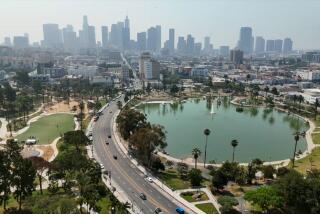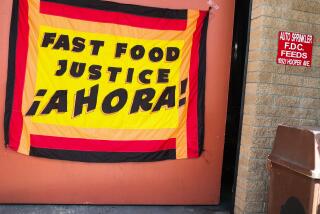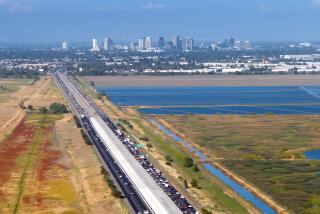Bradley Urges Partial Rush-Hour Truck Ban
- Share via
In his drive to ease rush-hour congestion, Mayor Tom Bradley on Wednesday detailed a program that aims to reduce by 50% the amount of heavy-duty truck travel during peak commute periods.
The program, subject to City Council approval, would also serve to reduce air pollution and enhance public safety, the mayor said. The city, working with the Highway Patrol and Caltrans, would also operate a “rapid deployment force” designed to quickly clear traffic accidents--the worst of which are caused by collisions involving big tractor-trailer rigs.
Under Bradley’s program, the city would ban most heavy trucks from city streets--but not freeways--from 6 a.m. to 9 a.m. and from 4 p.m. to 7 p.m., while issuing thousands of certificates exempting other trucks from the ban.
According to the plan, the vehicle identification system would effectively keep 70% of trucks that normally operate during peak hours off city streets, while providing certificates for about 30%, the mayor said. Overall, the truck traffic reduction on streets and freeways--where the city ban would not apply but would have an indirect effect--would be 50%, the administration says.
Trucks not bearing an exemption certificate would be cited and fined by police if operated during peak hours. Three-axle trucks weighing 29,600 pounds or more are affected under the proposal.
The system, if enacted, is expected to have a substantial impact on shippers and receivers, requiring them to expand delivery hours. Independent truckers, as well as smaller businesses that make few shipments, would be exempt.
Bradley detailed the program at a press conference on the Sports Arena parking lot--surrounded by smog and against a background of nine diesel rigs bearing the logos of such major firms as Jack in the Box, The Boys Markets and S.E. Rykoff foods--which have all endorsed the plan. The mayor said that more than a year of negotiations had produced a plan that major trucking concerns support, as well as the South Coast Air Quality Management District, Caltrans and the Highway Patrol.
“No one doubts that truck shipments are vital to our economy. The old saying, ‘If you got it, a truck brought it,’ still largely applies,” Bradley said in a press release. “But there is no logical reason so many truck deliveries must be made during these peak rush-hour travel times.”
Roles for Helicopters
In addition to reducing truck traffic, Bradley said, the program would also reduce the number of major traffic tie-ups caused by truck accidents. Money raised through $60 exemption fees and fines would be used to fund a “rapid deployment force” involving helicopter and heavy-duty tow trucks.
Bill Bicker, the mayor’s transportation policy adviser, said the program is unique in that there is no direct effort to restrict truck travel on freeways and highways, such as the Pacific Coast and Imperial highways. New York and other major cities have attempted to enforce such bans only to have federal judges block the attempts as violations of interstate commerce.
“We clearly have police powers and a duty to protect public safety on our streets. In no way are we trying to restrict interstate commerce,” Bicker said.
Bicker predicted the law would significantly reduce traffic tie-ups. In tracking traffic over a three-week period, Bicker said, it was found that large trucks are involved in about 12 accidents a day, two of which result in jams lasting more than two hours.
No one is sure how many trucks operate in the Los Angeles area, Bicker said. He estimated that more than 300,000 heavy rigs operate regularly in Los Angeles. About 100,000 could receive peak-hour exemptions under the plan.
Exemption certificates would be issued only to trucks meeting state safety guidelines. Independent truckers would probably receive automatic exemptions. Larger operators would receive permits for 30% of their fleet. An appeals board would evaluate and research individual cases, and could review truck company invoices to guard against fraudulent applications, Bicker said.
‘Critical’ Element
The partial truck ban, Bradley said, is the final and “most critical” element of his nine-point “free-flowing traffic proposal” first announced in June, 1987. The city’s Department of Transportation said that other elements in the proposal--such as synchronizing traffic lights and the mandatory towing of illegally parked cars during peak hours--have had a significant impact on traffic flow on many city streets.
Despite the show of support from some major firms, the program still faces strong opposition.
Karen Rasmussen, spokeswoman for the California Trucking Assn., representing more than 2,500 companies, said Bradley’s plan is “unfortunate” and suggested that it would not have a significant impact on traffic.
A recent Caltrans study, Rasmussen said, found that large trucks make up 4.4% of morning peak-hour traffic and 2.8% of evening peak-hour traffic. The study also showed, she said, that most accidents involving trucks occur at midday.
Dennis Woerner, manager of Pathfinder Trucking in Los Angeles, which has a fleet of more than 20 large rigs, predicted truckers will be able to adapt more readily than shippers and receivers.
“Trucking is a 24-hour business. The shippers and receivers will have to change their hours, and you’re looking at a lot of additional cost there,” he said.
Traffic and growth are considered a major issue in the mayor’s reelection bid against his expected challenger, City Councilman Zev Yaroslavsky, who has advocated restrictions on truck traffic on the freeways for more than a year.
Yaroslavsky said he was “pleased the mayor has come around to our way of thinking,” but said the proposal doesn’t go far enough. “This may be much ado about nothing,” Yaroslavsky said.
Regional solutions are needed, the councilman said. The city should work with the Congress to enact legislation for regionwide controls on truck traffic on freeways and highways to reduce traffic and improve air quality.
Officials of the Air Quality Management District said they would evaluate the mayor’s plan for possible regional application.
Two hours after unveiling the trucking plan, Bradley praised it to a group of developers and business owners in Encino as a good way to defuse slow-growth sentiment.
The irritation of traffic congestion is a strong reason for pressure to control growth, Bradley said in a speech to the Business Property Council. He predicted that the plan will become known as his administration’s most effective attack on traffic snarls.
“It’s revolutionary in nature, in many respects,” Bradley said.
Bradley, warmly received after being introduced as a champion of growth, also got in a few digs at critics of the city’s recent surge in development. Of the slow-growth cause, he said, “Unfortunately, we have become a society . . . of slogans that really aren’t accurate.”
Most of the city’s rise in population comes from births, Bradley said, and creating new jobs is important. “Whenever people suggest we should slow down growth, they don’t really understand,” Bradley said.
Times staff writer Kevin Roderick contributed to this story.
More to Read
Sign up for Essential California
The most important California stories and recommendations in your inbox every morning.
You may occasionally receive promotional content from the Los Angeles Times.










